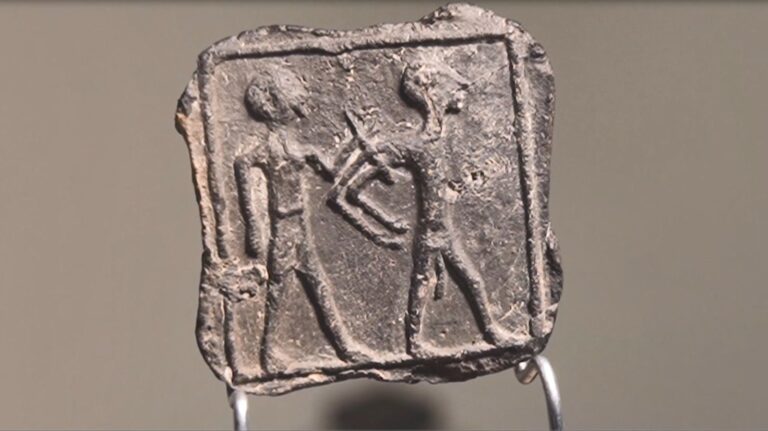Culture
6-Year-Old Israeli Discovers Rare 3,500-Year-Old Tablet
BY Itzhak Rabihiya
The clay tablet from the Canaanite period depicts a man leading a humiliated captive. The boy who found it won a certificate of good citizenship. The tablet, made of clay, depicts a captor leading a naked and humiliated captive. This tablet opens a visual window to understanding the struggles for control in the south of the country during the Canaanite period.
Six-year-old Imri Elya from Kibbutz Nirim near the Gaza Strip, went on an outing last March with his parents to tour the Tel Jemmeh archaeological site near Kibbutz Re'im. Suddenly, a small, square clay object 2.80 x 2.80 cm caught his eye. The curious boy picked up the object, and to his surprise saw two figures engraved on it. Imri's parents contacted the Israel Antiquities Authority and they handed over the item to the National Treasures Department. After photographing and documenting the artifact in the Israel Antiquities Authority's digital photography laboratories, archaeologists were surprised to realize that this was a unique and rare find that has not been discovered until today in archeological excavations in Israel.

According to research by archaeologists Saar Ganor, Itamar Weissbein and Oren Shmueli of the Israel Antiquities Authority, the artifact was imprinted in a carved pattern, and the artist's fingerprints even survived on the back. The tablet depicts the scene of a man leading a captive. This is an important figure wearing a skirt, holding a completely naked captive with hands folded and tied behind his back. It is evident that the artist sought to emphasize the captive's humiliation by showing him naked and perhaps to describe the ethnic differences between the captor and the captive by presenting each figure's different facial features - the captor's hair is curled and his face is full, while the captive is thin and his face elongated.
According to the researchers, "The artist who created this tablet appeared to have been influenced by similar representations known in Ancient Near East art. The manner in which the captive is bound has been seen previously in reliefs and artifacts found in Egypt and northern Sinai." Although the tablet was not found through an organized archaeological excavation, the researchers estimate, based on parallels to the Egyptian art world and local Canaanite art, that the artifact should be dated to the Late Bronze Age (between the 12th and 15th centuries BCE).
The violence portrayed raises interesting questions about the historical background of the tablet. During this period, the Egyptian Empire ruled Canaan. The latter was divided into "city states" ruled by local kings. From letters sent by Canaan kings of that period to Egypt (known as the El Amarna letters), it is known that internal struggles and control conflicts existed between Canaanite cities. In archeological research, Tel Jemmeh is identified with the Canaanite city of Yurza - one of the strongest Canaanite cities in the south of the country.
Researchers Ganor, Weissbein and Shmueli from the Israel Antiquities Authority believe that the scene depicted on the tablet symbolically describes the power struggles between the city of Yurza and one of the cities close to the Tel - possibly Gaza, Ashkelon or Lachish, or the struggle of a nomadic population residing in the Negev. The researchers believe that "the scene depicted on the tablet is taken from descriptions of victory parades; hence the tablet should be identified as a story depicting the ruler's power over his enemies. This opens a visual window to understanding the struggle for dominance in the south of the country during the Canaanite period."
According to Pablo Betzer, an archaeologist from the Southern District of the Israel Antiquities Authority, "Antiquities are our cultural heritage, and each find adds to the entire puzzle of the story of the Land. There is great importance in turning archaeological findings over to the National Treasures Department to be researched and displayed for the entire public to enjoy. The delivery of the tablet to the Antiquities Authority indicates value education and good citizenship on the part of Imri and his parents. Well done!"
Photo: Israel Antiquities Authority
Stories for you more +